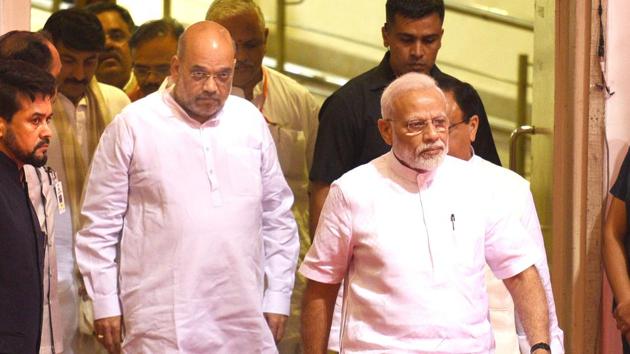The Amit Shah stamp on the Modi 2.0 govt is unmistakable | Opinion
A pushback is unlikely for now given the dominance of the BJP, but the Modi-Shah model will be tested
A 100 days and counting into the Narendra Modi government, what’s the biggest difference between Modi 1.0 and Modi 2.0? The answer to that question doesn’t lie so much in the Prime Minister’s Office, but across the street in North Block. The inexorable rise of Amit Shah as the unquestioned number two in the government is perhaps the most distinctive feature of the new regime.

Almost every major decision taken by the Modi government in its second coming bears the stamp of Shah. The effective scrapping of Article 370 is the most visible and dramatic example of the home minister’s impact on the government. Then, be it the amendments made to the Unlawful Activities Prevention Act, which gives sweeping powers to the National Intelligence Agency (NIA) to declare individuals as terrorists, the Right to Information Act amendments that have constricted the autonomy of the information commissioners, to presiding over every major Cabinet committee, Shah now calls the shots.
This development, however, is not unusual. When Modi returned to power in Gujarat for the first time in 2002, Shah was appointed minister of state for home, but also was in charge of as many as 12 portfolios in the state government at one time. He was seen as the eyes and ears of the Gujarat chief minister, tasked with executing the daily functioning of the state government even as Modi was the chief brand ambassador of the Gujarat model. It’s a relationship based on mutual trust, which worked effectively in Gujarat for almost a decade till Shah was forced to resign in 2010, when he was jailed over charges of having orchestrated fake encounter killings.
Even the Bharatiya Janata Party’s (BJP) original fellow travellers, AB Vajpayee and LK Advani who were prime minister and home minister during the two NDA governments between 1998 and 2004, cannot be compared to the new power couple. The “vikas purush” (development man) and “loh purush” (iron man) pairing was projected as co-mascots by the BJP at the time, a signaling that was built on the party’s desire to create an effective division of labour — Vajpayee as the more consensual, acceptable leader of a coalition government, and Advani as the hard-nosed ideological symbol of political Hindutva.
With Modi-Shah, on the other hand, this is a match made in a similar political crucible of Gujarat with no element of personal competition. Unlike Vajpayee and Advani, Modi and Shah belong to different generations. Shah is 15 years younger than the PM. Even when the duo shared the frame after the 2019 election triumph, Shah was careful to walk a step behind the PM. The home minister maybe a parallel power centre, but it is a role he plays without undermining Modi’s supreme leader status.
But the ascent of Shah goes beyond just a mutually convenient duopolistic power arrangement. It reflects a near-total ideological shift in the core task of governance in Modi 2.0. In particular, the nationalist fervour in governmental decision-making has now been taken to a new pitch. Witness Shah’s claim that he would like to extend the National Register for Citizens across the country. Or indeed his justification of the clampdown in Kashmir in unapologetic terms. Or his pushing for a Ram temple in Ayodhya at the earliest. In each instance, there is a visible religio-nationalist zeal that marks his pronouncements, which suggests a push towards a majoritarian worldview that has little mind space for constitutional morality.
Moreover, this unique power-sharing deal runs the same risk as Modi 1.0 did. An excessive centralisation of power to the point where the rest of the Cabinet, and even the parliamentary system, is rendered ineffectual. In the process, it faces the same potential pitfalls as the first Modi government did while taking arbitrary decisions like demonetisation. As 24 x 7 strong-willed politicians with a fierce risk-taking appetite, Modi and Shah are pushing government policy-making into uncharted waters without any compunctions. A certain unilateralism in approach has meant that there is little attempt at consultation and consensus-building with key stakeholders before major decisions are taken.
In a relatively small state like Gujarat, the Modi-Shah duo could work effectively because the entire political-bureaucratic order was beholden to them. In a more diverse polity, with competing interests at different levels, any attempt to impose a two-man show can slowly begin to unravel if there are no checks and balances. A pushback is unlikely for now given the complete dominance of the BJP over electoral politics, but there may come a time when the quality of governance will have to be separated from poll success. This is when, as at the moment on Kashmir and the economy in particular, the Modi-Shah model will be tested beyond just being an election-winning machine.
Post-script: As the Modi government celebrated 100 days in office, the prime minister was in Haryana invoking the ‘Isro’ spirit of positivity. Shah, on the other hand, was in Assam and talking tough on the National Register of Citizens and the Citizenship Amendment bill. While Modi seeks to reach out to the moon, Shah is driving the ideological agenda on the ground. Fast bowlers hunt in pairs, so it would seem do politicians.






